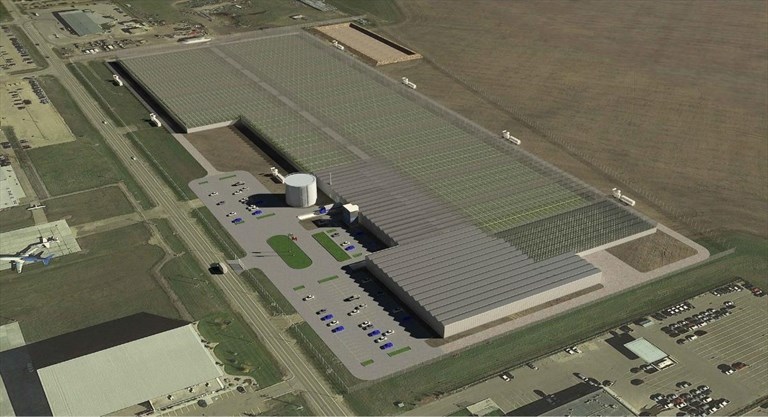Should Hamilton allow “monster” marijuana greenhouses?

City bureaucrats are floating the idea of allowing rural pot-growing greenhouses that are bigger than Lime Ridge mall.
The City of Hamilton is floating the idea of allowing rural pot-growing greenhouses bigger than Lime Ridge mall.
The potential policy change would allow legal medical marijuana growers to build greenhouses up to 90,000 square metres in size, or close to 1 million square feet. By comparison, the city's largest mall complex at Lime Ridge has 814,000 square feet of store space.
The option will be discussed at a Tuesday planning meeting, but not voted on until public feedback is gathered for a future report to council. Such a change would be a radical U-turn for a city that currently restricts rural grow-ops to 22,000 square feet.
The prospect of "monster" greenhouses faces opposition from leery residents who live nearby as well as from councillors like Lloyd Ferguson, who argued the rule change could "destroy farming" in Hamilton.
"I don't want food production land taken out of production," said the Ancaster councillor, who suggested "monster" greenhouses will eat up prime agricultural land and drive up the price of rural property beyond the ability of "real farmers" to buy.
Federally approved medical marijuana growers, on the other hand, have lobbied for less restrictive rules, arguing pot is now recognized as an agricultural crop — and the proposed large greenhouses look no different than those allowed for cucumbers or flowers.
Consultant John Ariens argued at a recent planning meeting the city's cap on building size was aimed at the idea of "bunker-style" buildings, not greenhouses.
"It should be treated the same as any other greenhouse operation in the city," he said in requesting approval for an amendment to allow a 140,000-square-foot marijuana greenhouse on Jerseyville Road for The Green Organic Dutchman. (Councillors last week put off a decision on that application.)
Right now, the city allows traditional food greenhouses to cover up to 70 per cent of the property where they are located and there is no square-footage limit for buildings.
The report going to councillors for consideration Tuesday notes relatively few Ontario or Canadian municipalities have square-footage limitations, but lot coverage maximums are more common and range anywhere from 10 to 80 per cent depending on the city and size of property.
Representatives from both The Green Organic Dutchman and Flamborough pot grower Beleave — which has applied to build a 107,000-square-foot greenhouse — are scheduled to speak at Tuesday's meeting.
Big looks to be the new norm, based on the footprint of successful industry pioneers.
Canopy Growth Corp. (formerly Tweed) was celebrated in the small Ontario town of Smith Falls for using pot to resurrect a nearly 500,000-square-foot former chocolate factory in 2014. Aurora Cannabis started building an 800,000-square-foot grow-op near the Edmonton airport last year.
The Green Organic Dutchman's requested greenhouse is small by comparison — but across-the-road neighbour Scott Herring was still "blown away" by the size of the project.
The Jerseyville Road resident brought his concerns about potential noise, odour and traffic problems associated with the project to councillors last week — even as he acknowledged he was one of the only residents living in proximity to the relatively isolated property.
His biggest worry, he said, is whether the supersized greenhouse would devalue his home of 20 years. "It's marijuana. It still has that stigma," he said.
Ferguson argued farmers and residents further afield should be worried, too, because of the potential of an influx of pot greenhouses to "suck the water table dry" and increase traffic on rural roads.
"We don't have buses running out to rural Flamborough or Ancaster," said the councillor, who noted the city is also allowing medical marijuana to be grown in vacant industrial buildings that can easily be serviced by transit and treated lake water.
But industry boosters have previously told council to give up on its dream of turning brownfields into "greenfields" full of legal pot, arguing Hamilton's industrial air pollution rules out the possibility of lower city operations.
Rural greenhouses, by comparison, use the sun to cut power costs and high-tech "water-recycling" minimizes the drain on groundwater, Ariens previously told councillors.
420 Intel is Your Source for Marijuana News
420 Intel Canada is your leading news source for the Canadian cannabis industry. Get the latest updates on Canadian cannabis stocks and developments on how Canada continues to be a major player in the worldwide recreational and medical cannabis industry.
420 Intel Canada is the Canadian Industry news outlet that will keep you updated on how these Canadian developments in recreational and medical marijuana will impact the country and the world. Our commitment is to bring you the most important cannabis news stories from across Canada every day of the week.
Marijuana industry news is a constant endeavor with new developments each day. For marijuana news across the True North, 420 Intel Canada promises to bring you quality, Canadian, cannabis industry news.
You can get 420 Intel news delivered directly to your inbox by signing up for our daily marijuana news, ensuring you’re always kept up to date on the ever-changing cannabis industry. To stay even better informed about marijuana legalization news follow us on Twitter, Facebook and LinkedIn.




